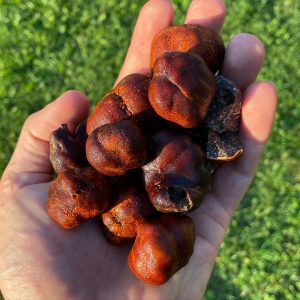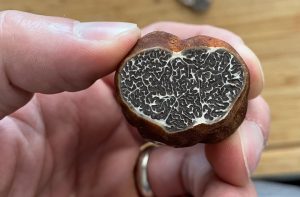Canaliculatum


Scientific Name
Tuber canaliculatum
Common Names
Michigan truffles, Appalachian Truffle, Yellow furrowed truffle
Seasons
August – November
Description
The peridium (skin) of this truffle is brick red at any stage of maturity. A cross-section through the truffle shows a marbled gleba (“flesh”) which ranges in color from almost white when immature to nearly black or charcoal when mature.
Although variable in size, it can produce quite large fruiting bodies, often composed with a few lobes. The outer surface or peridium of the truffle has a relatively smooth texture of small warts.
Individual truffles are oval in shape, may be irregular and depressed, and range from 2-12 cm across.
This truffles has an an exceptionally long shelf life and have been shown to preserve in proper conditions for over a month. Overly mature truffles are slimy or fuzzy and should NOT be sold.
Aroma/Flavor
Mature, ripe and choice fruiting bodies are characterized by a sweet but slightly musty odor that grows stronger with time. According to Dr. Jim Trappe (mycologist), famous chef, James Beard describes the Appalachian truffles as being “exquisite”.
Distribution
In the wild these truffles fruit across the Midwestern and Northeastern US, in association with spruce and pine, but also in mixed forests including those with oak, hickory, and birch. Truffles best collected with the aid of a trained truffle dog to ensure their quality, commercial value, and sustainability.
There are a few farms in the Northeast US attempting to cultivate these truffles.
See grading guidelines
Other species
- Tuber aestivum (black summer truffle)
- Tubber Borchii (bianchetto)
- Tuber Brumale (Muscato truffle)
- Kalapuya Brunea (Oregon brown truffle)
- Leucangium carthusianum (Oregon black truffle)
- Tuber canaliculatum (Appalachian truffle)
- Tuber gibbosum (Oregon white truffle)
- Tuber lyonii (pecan truffle)
- Tuber macrosporum (smooth black truffle)
- Tuber magnatum (white truffle)
- Tuber melanosporum (Perigord truffle)
- Tuber oregonese (Oregon white truffle)
- Tuber uncinatum (Burgundy truffle)

